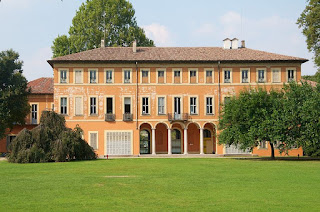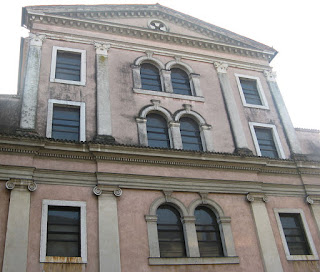Milan-born performer who became a Blackpool legend
 |
Charlie Cairoli became one of the world's
most famous clowns |
The circus clown Charlie Cairoli, who would at his peak set a world record by appearing at the Blackpool Tower Circus in England for 40 consecutive seasons, was born in Affori, now a suburb of Milan but then a town in its own right, on this day in 1910.
Cairoli performed at the Tower for the first time in 1939 and returned every year until 1979, quitting only when his health began to fail him.
The run was not broken even by the outbreak of the Second World War, which Britain entered soon after he arrived, or his own arrest as a suspected ‘enemy alien’. He was the Tower’s most popular attraction for almost all of those years.
Cairoli, though born in Italy, was actually from a French family, albeit one of Italian descent, who christened him Hubert Jean Charles Cairoli.
His father, Jean-Marie, was also a clown; his mother, Eugenie, came from another French circus family with Italian heritage, the Rocono. Charles - known as
Carletto - and his brother Louis-Philippe became part of the show as young children. Carletto made his debut at the age of seven.
At that age, he was doing little more than fetching and carrying for his parents, who were the stars. By the age of 17, he was entrusted with the role that would make him famous, that of the slapstick character known in the circus as an
auguste, the figure of fun who would inevitably end up with a custard pie in the face, their trousers ripped off or a bucket of water over their head. Cairoli adopted a red nose, a bowler hat and oversized shoes as his trade marks.
 |
Charlie Cairoli and his wife, Violetta.
during the TV show This Is Your Life |
When he was 24 and working in Paris with his father in their Cairoli Brothers act at the the Cirque Medrano at Montmartre, he met his future wife,
Violetta Fratellini, then only 19 and also from a famous circus family, who was there as part of a knockabout acrobatic act. Carletto showed off his musical talent by serenading her on the clarinet. By Christmas 1934 they were married.
In the winter of 1938, the Cairolis went to work in a Christmas pantomime in Birmingham, England. Clem Butson, the manager of the Blackpool Tower Circus, saw them in action and offered them a contract for the 1939 summer season.
When war broke out in September, Cairoli found himself in a difficult position. His father had French nationality and his brother had gone back to fulfil his military service. But Cairoli was born in Italy and was therefore Italian.
Before the war began he had applied for French citizenship but the papers had not come through. He even made the dramatic gesture of taking a watch he had given by the German leader
Adolf Hitler after a performance in Munich and throwing it into the sea off the end of Blackpool’s North Pier, in the hope it would make his allegiance clear.
 |
Cairoli regularly ended his Blackpool Tower Circus
shows soaked to the skin |
Nonetheless, along with many other Italians living in Britain, mainly in the catering industry, Cairoli was deported to the
Isle of Man.
Happily, proof of his French citizenship had arrived by October and he was able to return to the mainland, where he and his father spent the winter working in a munitions factory and appearing in variety shows before returning to Blackpool Tower for the summer season.
Cairoli was fortunate that Blackpool Tower Circus continued to operate throughout the war years, its location on the Lancashire coast just far enough away from the major cities to be relatively safe from bombing. And with foreign acts unable to travel to England, the Cairolis thrived.
He and Violetta established a good life in Blackpool, where they would remain for the rest of their lives. Cairoli’s popularity as a performer grew and the arrival of television saw his profile rise substantially in the ‘60s and ‘70s, with frequent television appearances both in Britain and America.
At the same time, he became a regular on stage in variety shows and pantomime, especially during the winters, including the Grand Theatre in
Leeds and Alhambra in
Bradford. On one occasion, he brought Christmas shopping in Leeds to a standstill as he led hundreds of youngsters through the streets to the City Varieties, where he gave a special show.
 |
| Cairoli had musical talent as well as a gift for comedy |
A measure of his status as one of Britain’s best-loved entertainers was an invitation in 1970 to appear on the hugely popular TV show
This Is Your Life.
Cairoli continued with a hectic schedule of performances until 1979, when exhaustion forced him to miss a number of shows at the Tower. In November of that year he announced his retirement, which lasted only a few months, sadly.
He died in February 1980 at the age of just 70, at his home on Blackpool’s North Shore. His widow, Violetta, survived him by 22 years. One of their three children, also called Charlie, revived his father’s character for cabaret and pantomime performances, but never appeared at the Tower Circus.
 |
The Villa Litta is a 17th century house within Milan's
oldest city park at Affori, where Cairoli was born |
Travel tip:
Since 1923,
Affori has been part of greater Milan and now has little to distinguish it from many other suburbs in the city, which now has a population of 1.25 million. There is evidence of a settlement in the area since 915 and there are some remnants of a medieval town, notably a 14th century watch tower that forms part of a more modern building in Via Osculati. Affori’s main historical building today is the Villa Litta, a 17th-century house located within Milan’s oldest city park. The villa, originally built by Count Pirro I Visconti Borromeo in the style of the Medici villas of Tuscany, it was subsequently owned by several families of the Milanese aristocracy, namely the Corbella, the D'Adda and the Litta.
Stay in Milan with Booking.com
 |
The Piazza Santa Maria Novella in Florence, where Giuseppe
Garibaldi gathered support for his Expedition of the Thousand |
Travel tip:
Violetta, Cairoli’s wife, was the granddaughter of Gustavo Fratellini, a circus trapeze artist and acrobat from
Florence who was also a follower of Giuseppe Garibaldi, the patriotic general who led the drive to Italian unification in the 19th century, most notably with his Expedition of the Thousand, which claimed Sicily, Naples and the southern part of the mainland on behalf of the new Kingdom of Italy. Fratellini may have been inspired by a major speech Garibaldi gave to a crowd gathered in Piazza Santa Maria Novella as he toured the Italian cities, gathering recruits for his army of red shirts.



























